Contact us today:
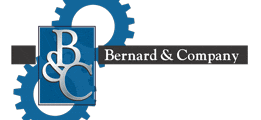
(847) 934-4500
tdaro@bernardandcompany.com

Contact us today:
(847) 934-4500
tdaro@bernardandcompany.com
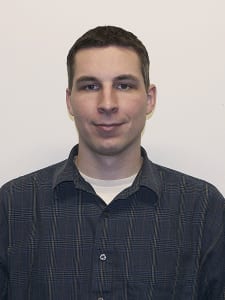
We are very pleased to announce the promotion of Christian Schedler to the Product Manager position at this division.
In his new role, Christian will oversee P&L responsibility for the division, including its sales, application engineering, product management and project management functions.
Christian’s distinguished career has encompassed R&D, Engineering and Product Manufacturing. He has a broad assembly and service experience on machine tools and knows the market’s needs for productivity improvements. Prior to this promotion, he worked in service as a Global Service Rep for a German machine tool company and as a Designer of carbide saws at Advanced Machine & Engineering. Christian has the experience, energy and judgment necessary to lead the division to continued success, insuring its future growth objectives are achieved.
Advanced Machine & Engineering Co., is a manufacturer located in Rockford, IL, serving the Machine Tool Industry with precision components and accessories, including spindle interface components, workholding devices, and, through our sister company, Hennig, machine enclosures, chip removal and filtration systems. The Fluid Power – Safety markets are served with cylinder rod locks and safety catcher devises; and the Production Saw market with our Amsaw carbide saw machines and Speedcut blade products. AME has manufacturing partners and customers around the world and across the U.S. To learn more, visit www.ame.com.
Hennig, Inc. design and produces custom machine protection and chip/coolant management products for state-of-the-art machine tools. Hennig products are designed to protect against corrosion, debris and common workplace contaminants. Manufacturing facilities located in the U.S., Germany, Brazil, India, Japan, China and South Korea. Repair centers are located in Machesney Park, IL; Chandler, OK; Livonia, MI; Blue Ash, OH; Mexico City, Mexico and Saltillo, Mexico. To learn more, visit www.hennigworldwide.com.
For more information, contact:
Tim Waterman
ADVANCED MACHINE & ENGINEERING CO.
2500 Latham St.
Rockford, IL 61103
Phone: 815-316-5277
Fax: 815-962-6483
E-mail: info@ame.com
Connect with AME online:
Steps to take for avoidance of imperfections in the aesthetics and surface integrity of gearworks
Roscoe, IL-Forest City Gear recently disseminated the following tips to its employees and would like to share these ideas with the gearmaking community, as well as users and assemblers of gearworks. This information is provided for reference only and any further questions or comments should be directed to author Fred Young, CEO of Forest City Gear. He welcomes all feedback.
BY: Fred Young, CEO
TO: All Forest City Gear Employees
Recently and historically, we have had issues with gears that suffered from the above conditions, after heat treat. These issues can also appear during hot and humid times, as well. We previously had a sand/vapor blast unit that was used to clean off debris and contamination from gears, prior to further processing.
My suggestions for future handling, based on experience and a reading of the current technology, include the following:
I welcome all your suggestions to further our desire for achieving “Excellence without Exception.” (This is the company motto at Forest City Gear.) I think that if all hands are on the lookout to address the corrosion, discoloration, contamination and pitting issues and address corrective procedures prior to further processing-gear grinding, cylindrical grinding or other machine operations- this will help minimize our overall cost. It is very difficult to address these issues after grinding has occurred, as you all know.
The September/October (2009) issue of Gear Technology had an article starting on page 60 entitled, “Gear Corrosion During the Manufacturing Process,” which focused on issues of pitting caused by corrosion, which can be very serious and ultimately lead to gear failure in operation.
While the article discussed the REM Chemical process of isotropic superfinishing in particular, much of the information is germane to the points above and will contribute to your understanding and resolution of these problems. I encourage you to read it. The watchword at Forest City Gear is that all of us are responsible to be on the lookout and take steps to prevent this situation from future occurrence, to the greatest degree possible. It will be prudent to gather some examples and point out exactly what we are trying to prevent from going out the door, by reviewing it with all hobbing/secondary, shaping and grinding department personnel, at the earliest opportunity.
For more information on this announcement, please contact: FOREST CITY GEAR CO., INC. Web: www.forestcitygear.com
Editor Note: Please send any publication-generated inquiries from this article to Wendy Young at Forest City Gear, wyoung@forestcitygear.com. Thanks much.
PR agency contact: Tim Daro Bernard & Company 847-934-4500 tdaro@bernardandcompany.com
Release: FOREST CITY GEAR CO., INC.
Date: January 26, 2010
Continue reading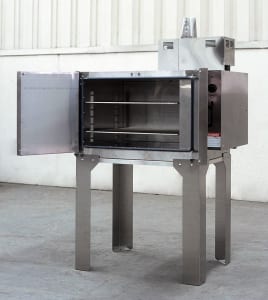
This Grieve bench oven features 2” insulated walls, leg support stand, Type 304, 2B finish stainless steel interior and exterior of brushed #4 stainless steel. Two oven shelves are also included.
Since flammable solvents are handled in No. 991, a powered forced exhauster with powered forced airflow safety switch to shut down heat if there is an exhauster failure, as well as a purge timer to allow the oven to exhaust four volumes of fresh air prior to turning on the heat source are all onboard.
For more information, please contact: THE GRIEVE CORPORATION, Web: www.grievecorp.com. Email: sales@grievecorp.com. Attention: Frank Calabrese.
Continue readingUsing Stotz air gages to validate spindle interface components, this leading supplier keeps quality on highest levels; every part, every time
Stotz USA, LLC, is a leader in air gaging technology, products and quality gaging system integration. According to company president, Chris Koehn, Stotz has achieved that goal by a variety of means, not the least of which has been the loyalty of good customers, who appreciate the value Stotz products brings to theirs. One of those customers is also a longtime friend of Koehn’s and he can say that with complete honesty, because he worked there, long ago.
Advanced Machine & Engineering (AME) of Rockford, Illinois is a world player in high-quality machine tool spindle interface components. As part of the Goellner, Inc. Group, AME enjoys a reputation throughout the machine tool industry for manufacturing the finest power drawbars, spindle shafts, guide bushings, locknuts, hydraulic sleeves, expansion gibs and more. AME components, through their own branded products and those of their brother companies such as OTT Jakob, Spieth and Tschudin & Heid, as well as their “other brother” Hennig, itself a world leader in chip conveyor and machine protection systems, are found on nearly every major machine tool brand.
AME was a customer of Stotz before Chris Koehn ever came to work at the air gaging company. Today, these two market leaders maintain a great working relationship, for all the right reasons. AME demands the highest level of quality in their machining and finishing departments and Stotz air gaging systems facilitate the accomplishment of that goal, every day, according to AME Service Manager, Greg Hobbs. “Air gaging is the only technology we’ve found that’s accurate enough to check the machine tooling and especially the spindle tapers we produce here. That’s a fact. In the past, we’d use hard gages and we still use them, but only for certain OD checks. We’d blue up the tapers, insert them, give them a good twist and do our inspections. Way too much inconsistency. Today, with sophisticated HSK tooling, this method is too hit or miss to be reliable. Air gaging provides dead stops on the test stand and the documentation is unbeatable for validation on the straightness, surface finish and taper angles. Plus, the Stotz system allows us to upload all the data on every part, so we have our favorite word…documentation…for every part we produce.”
Hobbs also commented on the user-friendliness of the Stotz air column. When the program is first input into the column for a part in the AME grinding department, for example, the Stotz column essentially becomes a PLC, providing hard data via the Ethernet connections to the host data base. In this manner, every parameter of every part is documented and recorded. In a classic example of the law of unintended consequences, this process is not only used on the parts run, it’s also used for calibrating the AME machines, in a predictive maintenance function.
At AME, various testing of machined spindle interface and other components is performed both at the machines in the grinding department, in a temperature-controlled 72° environment, plus in the company’s totally environment-controlled in-house testing department, supervised by the company’s Director of Quality, Brad Patterson. He confirmed Greg Hobbs’ observation that numerous other technologies have been investigated over the years for quality checking at AME and that air gaging has been found to be the best and most reliable for this company’s applications, particularly ID dimensions and configuration. Patterson also observed, “The sophistication of the Stotz air column is unmatched in the industry. We get all the data required and we get it in exactly the fashion needed to support our customers. Repeatable results and elimination of error, every time. Plus, the set-up is much faster than on our laser mics, which can’t be used for ID measurement.” Patterson further noted that the replacement of the bluing technique, one he termed a “black art,” with air gaging has brought and keeps AME up to the most current industry standards for quality evaluation.
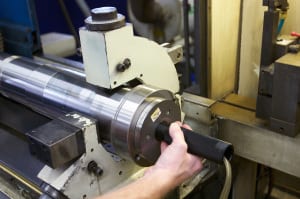
Typically, as AME’s Grinding Supervisor, Sam Schubert, explains, the finished product will rest for 24 hours of soaking, allowing the diameters to normalize. Though statistically predictable for most metal materials, thermal expansion can cause off-normal readings to occur. For checking certain bearing journals or spindle shafts, snap gages are set to accommodate size measurements down to the twenty millionths (0.000020”) range. The acceptable diameter tolerances for most AME products measured are in the 1-2 tenths (0.0001-0.0002”) range.
In cases where new masters are made for setting control values, those values are preset offline and programmed into the air column’s software, according to Greg Hobbs. Stotz typically performs this function for the customer in a remote manner over the Internet, through a proprietary IP address.
Among the many products finished in this grinding department are CAT/ISO 40 taper spindles, HSK test arbors, HSK grind quills, HSK steep taper milling tools and more. Often, older and worn spindle shafts are reverse engineered by AME for retrofits and reman’s. Even in these cases, air gaging is used to evaluate the finish process on the ID taper, as this versatile technology is easily adapted to such applications, according to AME personnel.
Sam Schubert expanded on the use of Stotz air gaging at AME.
“We have a full and very expensive inventory of hard gages with state-of-the-art indicators attached. But the air gages can do so much more. We use them for set-up on the grinding machines and they save us hours, every week. When you run the number of jobs we do here, that translates into substantial, additional work product and therefore more revenue for the company. In terms of reliability, some of the Stotz air gages we run here have been at AME since we began using the technology, nearly ten years ago now.” Schubert also noted the air gaging set-ups on the grinders dramatically reduce the time to first part in his department’s operation.
On one major spindle shaft project for an Asian machine tool builder, who was looking for a local source of supply in America, Schubert notes, AME was confronted with an unusually large quantity run, where tool degradation during the run would normally impact the production at some point. After an initial batch was produced, the machine builder claimed that everything but the taper was satisfactory. Quite surprised by this claim, AME checked all the documentation and determined that the customer’s test unit was actually out of spec, in a case where the error was repeated consistently and thus overlooked. In the end, the AME products were deemed better than perfect, in that instance.

As evidence of their commitment to this technology, Schubert notes that AME is now purchasing air gaging fixtures for all new customer applications. This quality spindle interface manufacturer aims to “keep breathing easy” in their process and product validation, as a result.
“Stotz has been a leader in gaging technology for almost 60 years. We are constantly striving to improve our designs and develop new products to solidify our position as a leader in measuring technology. The Stotz customer base consists of the top manufacturers and suppliers in the machine tool, automotive, aerospace and medical industries,” according to company president, Chris Koehn.
Harold Goellner, Vice President at AME, also contributed to this article.
For more information: STOTZ USA, LLC Email: chris@stotz-usa.com Attention: Chris Koehn, President
All photos kindly supplied by Bill Edmundson of Advanced Machine & Engineering
Release: STOTZ USA, LLC
Date: January 20, 2010
Continue readingAt both the AIST Iron & Steel Show and the Forge Fair, Advanced Machine & Engineering will be displaying their carbide circular sawing systems.
AMSAW® high-speed, production saw machines are specifically designed to use carbide blades to improve the cutting speed of ferrous and non-ferrous material, bars or billets, rails, profiles, pipes and tubes. Standard design features include:
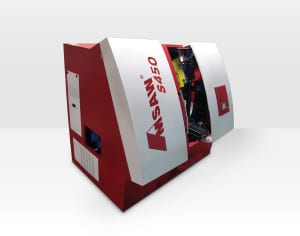
Also displayed will be various chip conveyors, safety devices and machine enclosures offered by AME and its sister division, Hennig.
Advanced Machine & Engineering Co., is a manufacturer located in Rockford, IL, serving the Machine Tool Industry with precision components and accessories, including spindle interface components, workholding devices, and, through our sister company, Hennig, machine enclosures, chip removal and filtration systems. The Fluid Power – Safety markets are served with cylinder rod locks and safety catcher devises; and the Production Saw market with our Amsaw carbide saw machines and Speedcut blade products. AME has manufacturing partners and customers around the world and across the U.S. To learn more, visit www.ame.com.
Hennig, Inc. design and produces custom machine protection and chip/coolant management products for state-of-the-art machine tools. Hennig products are designed to protect against corrosion, debris and common workplace contaminants. Manufacturing facilities located in the U.S., Germany, Brazil, India, Japan, China and South Korea. Repair centers are located in Machesney Park, IL; Chandler, OK; Livonia, MI; Blue Ash, OH; Mexico City, Mexico and Saltillo, Mexico. To learn more, visit www.hennigworldwide.com.
For more information, contact:
Tim Waterman
ADVANCED MACHINE & ENGINEERING CO.
2500 Latham St.
Rockford, IL 61103
Phone: 815-316-5277
Fax: 815-962-6483
E-mail: info@ame.com
Connect with AME online:
The SCHÖMA machine factory opted for a cycle turning machine with Sinumerik 840D solution line CNC for the manufacturing of individual parts and small batches of locomotive wheels; this machine also features Siemens ShopTurn with Manual Machine function. This hardware and software solution combines the flexibility and benefits of conventional machining with the productivity and efficiency of a CNC and this is what tipped the balance in its favor for one customer.
Christoph Schöttler Maschinenfabrik GmbH (SCHÖMA) is based in Diepholz, Germany. The company specializes in the development and production of diesel-engine locomotives. The model range includes tunnel and shunting locomotives; service, field and narrow-gauge locomotives; handcars, passenger carriages and gang cars. Around 90 percent of the locomotives produced each year at SCHÖMA are destined for use in tunnel construction.
Each construction project brings its own specific requirements and each country through which the locomotives travel has different environmental and safety legislation. SCHÖMA uses a modular system to meet a diverse range of customer requirements and the resulting need for a variety of equipment and product versions. One of the tasks facing the company is working out how to equip the locomotives for transportation by rail on differing track widths. Another requirement is locomotives with driving wheels featuring diameters between 600 mm and 900 mm, depending on local track usage.
Faced with even more demanding requirements in terms of production capacity and flexibility, SCHÖMA’s Managing Director, Christoph Schöttler, last year decided to add a cycle-control Seiger Record LC 1400 lathe to his inventory of machines. “We opted for a head turning machine, as we do not need a tailstock to produce driving wheels, axle bearing housings and gear wheels. It is working just as we envisioned, so we obviously made the right decision,” says Schöttler.
SCHÖMA constructs around 120 locomotives each year, which equates to 480 wheels. In addition, there are also repair orders, which increase the workload to between 560 and 600 driving wheels per year. These wheels are produced in two mountings from forged blanks on the cycle turning machine. The first mounting is used to machine the wheel flange on the reverse side and the wheel hub. The shaft locating bore is pre-turned. In the second mounting, the first task is to pre-turn the driving wheel profile, then the rolling circle level and the wheel shaft locating bore are finished.
Careful approach
The cycle turning machine is controlled by a Siemens Sinumerik 840D sl CNC, equipped with the ShopTurn software package with Manual Machine feature. If required, ShopTurn programming can be performed on a separate PC as part of an operator’s work planning, without interrupting the work sequences on the machine. The programs are routed to the machine via the network, where they are called up as required, depending on the workpieces to be produced. The Sinumerik CNC is used for both numerically controlled machining and manual operation with the ShopTurn’s Manual Machine functions. In manual mode with electronic handwheels, the machine behaves just like a conventional lathe with an actual value display.
During face and longitudinal turning, the process operates with the entered feed and spindle speed. The real highlight of the system is that every cycle can be used straightaway, without having to create a custom program. At SCHÖMA, the option for manual intervention is used for setting the zero point or for simple contours. Diameters are determined manually, if driving wheels have been newly profiled or if driving wheel profiles require resurfacing. The wheel profiles abrade as a result of the high loads experienced in heavy-duty operation or on poor-quality tracks or as a result of the driven wheels skidding.
“With a machine that uses only CNC, it is difficult to rework the driving wheels, as it is not possible to determine how much material needs to be removed. With this optional manual mode, however, users can adopt a careful approach. This sums up the ease of control,” explains Walter Horstmann, head of mechanical production and wheel set construction at SCHÖMA.
Siemens ShopTurn with Manual Machine for the job shop
After machine start-up, the basic MANUAL screen is immediately displayed and offers direct access to choosing machining options without having to create a parts program.
Machining procedures such as “taper turning” and “straight line face and longitudinal turning” can be executed immediately. The operator simply selects tool, feed speed, spindle speed and orientation, plus, if required, machining angle, then presses “Start”. The active direction is graphically displayed in the basic screen, using a compass rose symbol. All machining steps such as entry, thread grinding and drilling can also be started in manual mode.
For additional product information and inquirie, contact:
SIEMENS MACHINE TOOL BUSINESS
John Meyer
Manager, Marketing Communications
Siemens Industry, Inc.
(847) 640-1595
www.usa.siemens.com/cnc
SiemensMTBUMarCom.industry@siemens.com
Follow us on Facebook: www.facebook.com/SiemensCNC or Twitter: www.twitter.com/siemens_cnc_us.
—
Siemens Industry Sector is the world’s leading supplier of innovative and environmentally friendly products, solutions and services for industrial customers. With end-to-end automation technology and industrial software, solid vertical-market expertise, and technology-based services, the sector enhances its customers’ productivity, efficiency and flexibility. With a global workforce of more than 100,000 employees, the Industry Sector comprises the Industry Automation, Drive Technologies and Customer Services Divisions as well as the Metals Technologies Business Unit. For more information, visit http://www.usa.siemens.com/industry.
The Siemens Drive Technologies Division is the world’s leading supplier of products, systems, applications, solutions and services for the entire drive train, with electrical and mechanical components. Drive Technologies serves all vertical markets in the production and process industries as well as the infrastructure/energy segment. With its products and solutions, the division enables its customers to achieve productivity, energy efficiency and reliability. For more information, visit http://www.usa.siemens.com/drivetechnologies.
Continue reading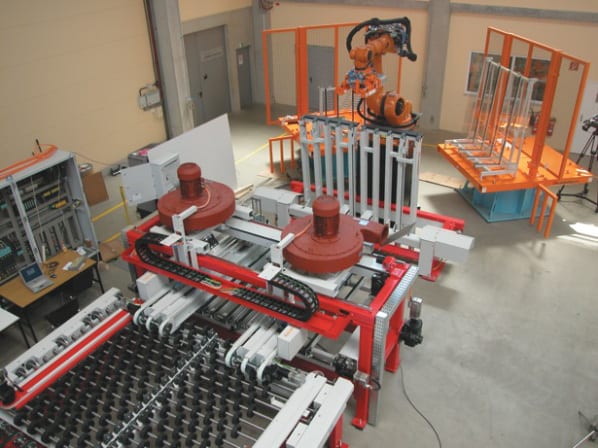
The float glass industry is facing multiple challenges, not the least of which is a growing array of applications requiring a broader offering of products and sizes, and competition from offshore producers.
The need for more flexibility and speed in the production process has never been so important. Similarly, the necessity to reduce production costs and optimize profit margins has never been so critical. Smart glass producers are finding that replacing manual functions with streamlined automation is not only meeting these objectives, but also has become a requirement for long-term stability and success.
Of all the functions on the float glass line, stacking remains the most labor intensive, and therefore a key target for automation. Glass producers have been looking for a more efficient, reliable and cost-effective method to stack the expanding selection of glass sizes they manufacture. Some producers have automated their stacking, but have experienced difficulties with speed of throughput, because of glass stacking displacement causing breakage.
But many more float glass producers are still handling stacking manually without the aid of any controls automation.
Fully automated cold-end line
Effectively streamlining the uniformity and quality in the making of plate glass – a new generation of glass-handling equipment has emerged, which is destined to change the landscape of cold-end line process efficiencies. Developed by Grenzebach, in tandem with Siemens, a new line of glass-handling equipment is being released featuring integrated controls systems that provide a fully automated solution to the handling of finished float glass. Every function of the cold-end line is being integrated into one controls automation platform – including take-over of the glass from the lehr, cutting the glass ribbon into sheets of optimum size, glass snapping, rejection of faulty glass sheets, sorting according to size and quality, and stacking into glass racks with robotics.
The cold-end line requires that multiple, continuously-operating functions be precisely and sequentially connected. Grenzebach and Siemens have effectively brought each of these functions into one complete and totally integrated automation controls system, with the net effect of reducing production costs and increasing throughput. This package of automation controls is equally applicable to individual machines in the line, so additional line equipment can easily be added to the system at the discretion of the plant.
Grenzebach
Grenzebach is a pioneer in float glass cold-end equipment. In 1974, the company developed the world’s first processing systems for automated float glass production. In addition to machines for transport and handling operations, and cutting and breaking lines, systems for identifying flaws, glass quality control and optimization of material yield have also been created.
Grenzebach Corporation is the U.S. subsidiary of Grenzebach Maschinenbau GmbH of Hamlar, Germany, which is a global manufacturer of production equipment for the flat glass and construction material industries. It is recognized as an international mechanical engineering company, with development and production facilities in Germany, the United States and China. Worldwide, the Grenzebach Group has some 1,400 employees.
High-Speed Stacker
The first piece of Grenzebach equipment to exclusively utilize this advanced automation technology is the company’s new High-Speed Stacker. Designed to increase glass manufacturer’s efficiency and flexibility, it was developed for stacking small glass formats with high cycle times, and is currently the only device which can stack glass sheets in less than a one-second cycle. The new system is the world’s most flexible glass stacker.
It is a robot-assisted float glass stacker, which reaches its speed from quickly forming sub-packs of glass and achieves its flexibility by stacking the sub-packs with a robot. The system improves employee working conditions and stacking accuracy and efficiency, while decreasing product damage and ultimately costs. The High Speed Stacker is an ideal answer to today’s flexibility and speed demands in the glass manufacturing industry.
The High-Speed Stacker stacks glass formats from 12” x 18” up to 73” x 97”, and then transports glass sheets by a suction belt into a packet frame, where each sheet is placed successively until a sub-pack has been created. Next the packet is transported to a robot for take-off, either from above or from the side, to be stored on a glass rack that is used to transport the product to other facility locations or to end customers.
The system’s six-axis robots are capable of correcting the stacking alignment and creating precise glass stacks. For small glass sheets, two packets are built up and stacked parallel. Using this production method, up to 80 glass plates per minute can be taken off and stacked. The robots have a payload capacity of up to 220 lbs. and also feature integrated energy supply systems to reduce floor space.
The stacker can stack multiple sizes of glass with varying orientation – landscape or portrait, tin side in or tin side out with accuracy and speed. The High-Speed Stacker offers manufacturers the flexibility to adapt to product variations and rack and equipment changes. Feeding can be performed in a double stream, so that two packets are built up and stacked in parallel. It can be integrated into existing side-legs, but also demonstrates its stacking qualities in off-line cutting operations.
High-Speed Stackers can automate the entire packing capacity of a typical float glass production line, and can completely eliminate manual packing of glass.
Ideally, the angle of the glass rack is known and accurate. Since glass is heavy and the racks are being exposed to rough handling during regular operations, this angle can change over time compromising the structural integrity of the rack. As a result, a conventional stacker would not stack the glass in an optimal manner and glass breakage could occur. The robot of the Grenzebach High-Speed Stacker scans the rack for dimensional and angular discrepancies and adjusts its stacking program according to the actual geometry of the rack.
“Our customers have been demanding a better solution for stacking the many different glass sizes that they manufacture,” says Gerald Haas with Grenzebach Corporation. “Until now, they have had to rely on manual labor for their stacking operations. With the High-Speed Stacker, not only do they improve their employee’s working conditions, but they increase their operational efficiency and flexibility.”
Grenzebach’s totally automated cold-end line, and specific application to the High-Speed Stacker, is functionally based on Siemens’ concept of Totally Integrated Automation (TIA). TIA is characterized by its unique continuity. It provides maximum transparency at all levels with reduced interfacing requirements. It encompasses the field level and production control level, up to the corporate management level.
It also provides maximum interoperability, covering the controller, HMI and drives, up to the process control system. This reduces the complexity of the automation solution in the plant.
Motion Control, PLCs and Tech functions in one system
Central to Siemens’ TIA system in place with the Grenzebach line and High-Speed Stacker is SIMOTION®, Siemens latest generation of motion controller. SIMOTION, which includes a palate of high-tech control system components which are optimally harmonized.
Most machines require motion control (positioning, synchronous operation), PLC functionality and technology tasks (i.e. pressure control and temperature control).
The fusion of these functions into one system – as with SIMOTION – has a number of advantages, such as lower engineering costs, higher machine performance, the elimination of time-critical interfaces between individual components and simple, uniform and transparent programming and diagnostics for the entire machine with a single tool. The focus here is placed on a simple and flexible solution for numerous motion control tasks.
The motion controller, the drives and the motors encompass the scope of the Grenzebach cold-end line needs. This was a very big step forward technologically for Grenzebach, in terms of the wiring, drive integration and motion control. Taking standard, off-the-shelf Siemens technologies and applying them to a machine solution presented significant advantages to Grenzebach as an OEM.
Integrated with SIMOTION is Siemens SIMATIC® S7-300 automation system. Applicable for centralized and distributed configurations, it has the ability to integrate powerful CPUs with Industrial Ethernet/PROFINET interface. It can be set up in a modular configuration without the need for slot rules with I/O modules.
The Siemens SIMOTION motion control and SIMATIC controller provide a fusion of motion control, PLC and technology functions in one unit. This means that the new sophisticated stacking robots in use with the High-Speed Stacker can now be more easily controlled and operated.
Improved safety
A critical requirement of machine manufacturers and operators is seamless safety between humans and machines.
A truly safety-integrated system is a complete and consistent safety portfolio, which covers all tasks to be accomplished in the field of safety technology – ranging from detecting through evaluating, to reacting. In float glass production, safety is a critical concern. The automation built into the Grenzebach system greatly increases safety with handling sheet glass, resulting in far less accidents and injuries.
The Siemens S7 controllers are SIMATIC Safety Integrated, which provide the highest level of safety for humans, machines and environ¬ment. They are used to prevent accidents and damage resulting from a fault or mal¬function. The safety SIMATIC controllers monitor themselves, detect faults autonomously and immediately change into or remain in a safe mode when a fault occurs. They are optimized for use in production engineering and provide air-tight safety for all operations.
Fail-safe CPUs have been exercised for safety-oriented applications with the Grenzebach High-Speed Stacker and all other equipment on the cold-end line. The PROFIsafe profile for safe communication via PROFIBUS and PROFINET allows the integration of safety-related functions into standard automation environments.
Automation for a changing market
“We are making the SIMOTION and SIMATIC technology available to float glass producers so they can benefit from its system-wide controls capability and streamline their cold-end line production,” says Chad Shaffer with Siemens.
“This totally-integrated solution has been successfully applied to many other industries, but it is quite unique to float glass production until now.”
“Siemens has teamed with Grenzebach to help effect production efficiencies in the glass industry,” continues Shaffer. “More efficient equipment, safer production systems and a better bottom line for glass producers are our objectives.”
As glass producers deal with the influence of an increase in cheaper off-shore glass being imported and a more diverse product mix, production automation is more important than ever before. With new equipment providing better solutions, like the High-Speed Stacker equipped with a truly integrated controls package, glass fabricators stand in a much better position to operate their plants more efficiency and maintain a more competitive stature in the market.
Grenzebach Corporation can be reached by contacting: www.grenzebach.com
Grenzebach is a pioneer in float glass cold-end equipment. In 1974, the company developed the world’s first processing systems for automated float glass production. In addition to machines for transport and handling operations, and cutting and breaking lines, systems for identifying flaws, glass quality control and optimization of material yield have also been created.
The first piece of Grenzebach equipment to exclusively utilize this advanced automation technology is the company’s new High-Speed Stacker. Designed to increase glass manufacturer’s efficiency and flexibility, it was developed for stacking small glass formats with high cycle times, and is currently the only device which can stack glass sheets in less than a one-second cycle.
OR
SIEMENS INDUSTRY, INC.
Drive Technologies — Motion Control
390 Kent Avenue
Elk Grove Village, IL 60007
Phone: 847-640-1595 Fax: 847-437-0784
Web: www.usa.siemens.com/motioncontrol
Email: SiemensMTBUMarCom.industry@siemens.com
Attention: John Meyer, Manager, Marketing Communications
HAN-KWANG INTRODUCES THREE NEW LASERS
Korean giant enters U.S. market with big splash at recent FABTECH show
At the recent FABTECH show in Chicago, the largest builder of laser machines in Korea introduced three new CO2 lasers for metal fabrication, including two plate/sheetmetal machines and one tube/pipe cutter. Reaction from the attendees was very positive and interest quite high, as all three machines ran continuously throughout the show.
Details on the machines follow here:
Han-Kwang takes the next step in its technology development with the introduction of the Series PL laser system. Incorporating our unique Beam Radius Control (BRC) and Constant Beam Delivery System (CBDS), Series PL also features the newest Han-Kwang laser technology, our S5 High-Speed Cutting Head, which significantly increases the cutting speeds on all sheet metals, up to 1120 IPM for 20ga mild steel and 790 IPM for 16ga stainless. In addition, the practical machine design and highly functional, ergonomic controls make the Series PL the new benchmark in long gantry laser systems.
Features
• BRC-Beam Radius Control
Through optimizing the beam diameter for each different material and thickness, cut quality is greatly increased.
• CBDS-Constant Beam Delivery System
By keeping the entire length of the beam delivery constant over the work area, beam quality at the cutting focal point is enhanced.
• S5 High Speed Cutting Head
Adopting the new generation of the sensing board and the cutting head means cutting speeds for sheet metals such as mild steel, stainless and aluminum are dramatically increased.
• PMU-Plasma Monitoring Unit
Constantly monitors cut error such as plasma and restart with faster piercing and more stable cutting quality.
• LCS-Lens Crack Sensor
Built-in LCS monitors the status of lens contamination to give maintenance personnel instant alerts for replacement.
• Rotary axis for tube cutting
Cuts tubes up to 12” OD to give your operation substantial flexibility in work strategies
• Siemens SINUMERIK 840D with 15” touch screen
Use of the highest powered CNC, with open architecture and simplified set-up with plain language commands, plus full interface to your shop programming/monitoring network, means greater productivity at the machine and overall in your operation
• Onboard high-efficiency air filter & dehumidifier with monitoring window
Utilizing its own power supply, this unique Han-Kwang system guarantees contamination-free cutting and unmatched consistency.
—————————————————————–
Han-Kwang takes the next step in its technology development with the introduction of the Series PS laser system. Incorporating our unique Beam Radius Control (BRC) and Constant Beam Delivery System (CBDS), Series PS also features the newest Han-Kwang laser technology, our S5 High-Speed Cutting Head, which significantly increases the cutting speeds on all sheet metals, up to 1120 IPM for 20ga mild steel and 790 IPM for 16ga stainless. In addition, the practical machine design and highly functional, ergonomic controls make the Series PS the new benchmark in short gantry laser systems.
Features
• BRC-Beam Radius Control
Through optimizing the beam diameter for each different material and thickness, cut quality is greatly increased.
• CBDS-Constant Beam Delivery System
By keeping the entire length of the beam delivery constant over the work area, beam quality at the cutting focal point is enhanced.
• S5 High Speed Cutting Head
Adopting the new generation of the sensing board and the cutting head means cutting speeds for sheet metals such as mild steel, stainless and aluminum are dramatically increased.
• PMU-Plasma Monitoring Unit
Constantly monitors cut error such as plasma and restart with faster piercing and more stable cutting quality.
• LCS-Lens Crack Sensor
Built-in LCS monitors the status of lens contamination to give maintenance personnel instant alerts for replacement.
•Siemens SINUMERIK 840D with 15” touch screen
Use of the highest powered CNC, with open architecture and simplified set-up with plain language commands, plus full interface to your shop programming/monitoring network, means greater productivity at the machine and overall in your operation
• Onboard high-efficiency air filter & dehumidifier with monitoring window
Utilizing its own power supply, this unique Han-Kwang system guarantees contamination-free cutting and unmatched consistency.
—————————————————————–
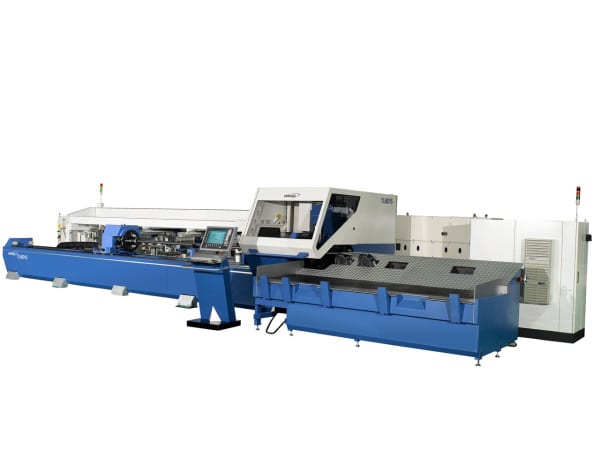
Highlight of the Series TL is our highly advanced S5 cutting head, which combines superior measurement and sensing mechanisms to change from signal size to pulse monitoring, resulting in optimum cutting conditions. This new cutting head design is further enhanced by Han-Kwang’s quick piercing nitrogen-injection technology. Smaller holes, quicker ambient area cooling and a substantial reduction in hole-to-hole cutting time will all benefit your production and your bottom line.
Features
• BRC-Beam Radius Control
• CBDS-Constant Beam Delivery System
• Magazine-fed bundle tube loading system
• Tube V-support system
• Rotary chucking system
• Completely enclosed safety workstation with automatic doors and light barrier system
• Panasonic 2500W resonator
• Cutting capability to 21’ long x 6” diameter
• Material thicknesses to 0.25” mild steel and 0.2” stainless
• Siemens SINUMERIK 840D, the highest-powered CNC on the market for maintaining complete processing cycle control by a single operator, using touchscreen and simple language commands
• ProDesign 3D CAD/CAM enabling fast adjustments to the production scheduling to yield maximum productivity from the system
• Unique Han-Kwang air filtration and dehumidifying system for cleaner cuts and more operator-friendly environment
For more information on this emerging new player in the laser machine market, please contact:
Robert Won, Director/North American Sales
HANKWANG USA, INC. Web: www.hankwang.com
Agency contact: Tim Daro Bernard & Company www.bernardandcompany.com
Production boost of 20% reported by Amgraph on food packages
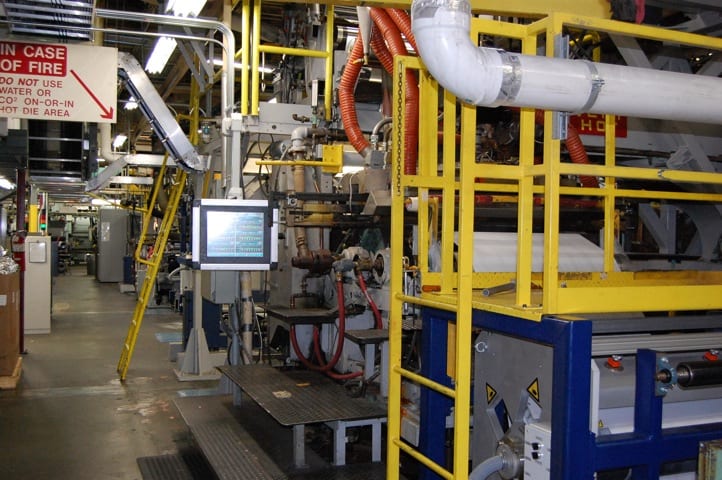
As a result of the retrofit, Amgraph can now produce a wider variety of coated plastic and foil flexible food packages, cut material expenditures and improve throughput, while boosting productivity.
Improved Web Tension
Siemens Solutions Partner, Circonix, located in Ringwood, N.J., knew that by upgrading the machine’s analog drives and discrete controls to the latest Siemens motors and Sinamics S120 digital drives, Amgraph could accommodate new materials, manufacture packages with thicker coatings, achieve uptime of 95 percent or better, and increase throughput by 20 percent or more.
“Initially, the machine had four different motors with analog drives and controls, each with their own wiring harness and relay logic, which really made the machines a challenge to maintain,” explained Circonix Vice President of Engineering Andrew Alaya. “Only one of the sections was capable of tension control, which forced Amgraph to operate the extrusion machine in draw mode. This meant that the machine could only handle certain types of coatings without breaking the web and going down. Improving that uptime through better tension control was the main goal of the project.”
Circonix engineers decided to retrofit the Extruder’s four existing analog drives with Siemens motors and Sinamics S120 drives, while adding four load cells inline, and a new Fulton Machinery dancer to the machine’s two unwind spindles. Also, two Vetaphone treaters were added inline as part of the retrofit. These effectively eliminated the need for the primer coater, and served as pull stations for the machine, which were driven by Siemens motors and drives. These modifications allowed the machine to work in closed-loop tension control mode. By changing values on the HMI and PLC, Amgraph’s Production Manager, David Rand, could now precisely control the speed and thickness of the web, turn various systems such as treaters, laminators, and tension control systems on or off, and apply either thinner coatings to package materials without worrying about additional web breaks and downtime, or thicker coatings to meet special customer needs.
“Now that we have more control of the system, we’re looking at replacing thicker films that we used to purchase from other vendors with extruded materials we make ourselves, which saves us money,” says Amgraph’s Rand. “Our initial trials have been successful.”
The new motors, upgraded digital drives and new controls also increased the extrusion machine’s uptime, throughput and productivity. The high bandwidth of the Sinamics S120 digital drives allows for improved speed regulation and faster response, both of which are key to improving tension control. Amgraph set aggressive goals of 95 percent uptime for the retrofitted extrusion machine. “We’ve had some success since the machine was installed in January,” says Amgraph’s Rand. “We spent a few months fine-tuning operations, [but] recently, we’re starting to see [uptime] benefits. We should have some firm numbers in the next few months.”
In addition to increasing uptime and the number of products the machine can handle, Rand says the retrofit has increased throughput by up to 20 percent, depending on the product line. “We’ve definitely increased production speeds,” he said. “We’re happy where we are now, but we still have opportunities to improve throughput.”
On time, Within Budget
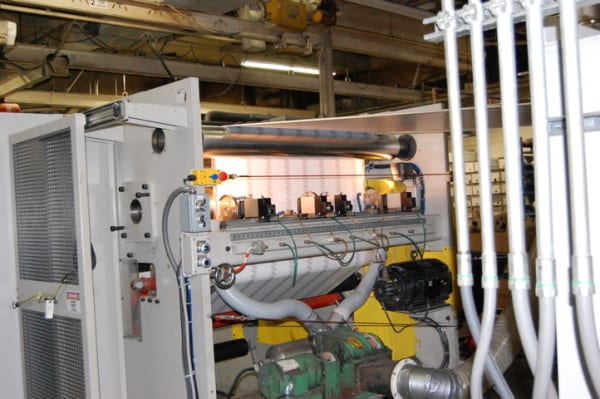
Customers may also want to use specific equipment providers for certain systems. In this case, Amgraph was familiar with third-party HMI and PLC technology, which meant Circonix needed to interface the Sinamics S120 drives with third-party systems. However, thanks to Circonix’s close partnership with Siemens as an official Siemens Solutions Provider, Siemens’ STARTER drive engineering/commissioning software and the easy integration of the Sinamics S120 drives using the electronic name plate capabilities of Drive-Cliq for the motors and drive components, the project was delivered to Amgraph on time and within budget.
“We used Profibus to tie the drives together and an SST module in the PLC to talk to the Siemens drives,” Alaya explains. “It was easy to meet Amgraph’s development schedule. With Siemens DC bus line up, all the drives fit in a single cabinet that was smaller than the space of one of the previous motor control systems. We were able to eliminate the wiring mess and relay logic that came with the older analog controls, which significantly simplified maintenance and troubleshooting for the customer while improving performance and uptime.”
Circonix started engineering development for the system in July of 2008, and just six months later, installed and commissioned the retrofits.
“We gave them a pretty intense schedule,” says Amgraph’s Rand. “What’s remarkable about this project is that it was done on-time. We have some machines that came in before we did this project and they’re still not up and running.”
For specific product information and inquiries, call (800) 879-8079 ext. Marketing Communications or send an e-mail to: SiemensMTBUMarCom.industry@siemens.com.
Continue readingI had a speaking engagement today where I spoke about Social Media to a Human Resource association. I was discussing how Twitter, blogging and YouTube work best when they go hand-in-hand with each other. This topic came up here at work recently and this is how I put it into perspective:
When you develop a great video presentation and bring it to a trade-show or conference, you don’t just set it up on a table and leave it playing in a loop all by itself. You don’t just start the presentation and leave it unattended do you? Instead, you are there ready to greet people who show any interest in the presentation you are running. You are there to answer questions, make conversation and interact with others. As we all know, this is called networking. Likewise social media, when used correctly establishes this same type of interaction. Videos on YouTube need to be associated with a website, or a blog where someone interested can go and interact and ask questions. Once a connection is made and a conversation is started, it is just like you are standing together at the trade-show, or in the conference room. Here, in the discussion that evolves, whether it be virtual or in person, you will decide whether continuing a business relationship or not is in your best interest. So in both scenarios (virtual or in person) the same objective is being met.
Likewise, it’s important that once you post something on YouTube you have methods in place to draw traffic to the video. This is where your website, Facebook, Twitter and blog will play their part in this dance of getting your online presence noticed. Social Media needs to work together and be in harmony with each other. Working together is the key to the success of your social media campaign as well as your overall marketing plan.
We have a client who posts videos on YouTube, at the end of their Print Ads in the trade magazines we print: “see our videos on YouTube”… how is that for the evolution of the ad/PR world? We now have our traditional print ads referring potential clients (and anyone else who is interested) to our client’s online presence. At least for right now, it seems you can’t effectively have one without the other.
-Wendy
Continue reading